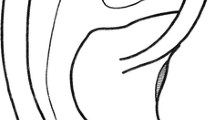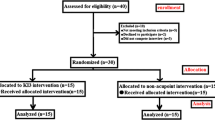Abstract
Objective
To study, through blood oxygen level dependent functional magnetic resonance imaging (BOLD fMRI), the cerebral activated areas evoked by electro-acupuncturing (EA) the right Hegu point (LI4) or non-acupoint points on the face, and through comparing their similarities and differences, to speculate on the specific cerebral areas activated by stimulating LI4, for exploring the mechanism of its effect in potential clinical application.
Methods
EA was applied at volunteers’ right LI4 (of 9 subjects in the LI4 group) and facial non-acupoint points (of 5 subjects in the control group), and whole brain 3-dimensional T1 anatomical imaging of high resolution 1 × 1 × 1 mm3 used was performed with clustered stimulatory mode adopted by BOLD fMRI. Pretreatment and statistical t-test were conducted on the data by SPM2 software, then the statistical parameters were superimposed to the 3-dimensional anatomical imaging.
Results
Data from 3 testees of the 9 subjects in the LI4 group were given up eventually because they were unfit to the demand due to different causes such as movement of patients’ location or machinery factors. Statistical analysis showed that signal activation or deactivation was found in multiple cerebral areas in 6 subjects of LI4 group and 5 subjects of the control group (P<0.01). In the LI4 group, the areas which showed signal activation were: midline nuclear group of thalamus, left supra marginal gyrus, left supra temporal gyrus, right precuneous lobe, bilateral temporal pole, left precentral gyrus and left cerebellum; those which showed signal deactivation were: bilateral hippocampus, parahippocampal gyrus, amygdala body area, rostral side/audal side of cingulate gyrus, prefrontal lobe and occipital lobe as well as left infratemporal gyrus. In the control group, areas which showed signal activation were: bilateral frontal lobe, postcentral gyrus, Reil’s island lobe, primary somato-sensory cortex, cingulate gyrus, superior temporal gyrus, occipital cuneiform gyrus and/or precuneus gyrus and right brainstem; and the area that showed deactivation was left median frontal lobe.
Conclusion
The effects of EA LI4 in regulating cerebral activities could be displayed and recorded through BOLD fMRI, the distribution of signally deactivated area evoked by EA LI4 was similar to the known distribution of anatomical orientation of pain in brain, and closely related to the anatomic structure of limbic system, which areas are possibly the acupuncture analgesic effect’s cerebral regulating area. Furthermore, activated portion of left central anterior gyrus, which represent the movement of oral facial muscles, and the activated portion of cerebellum are possibly related with the effect of using EA LI4 in treating facial palsy and facial muscle spasm. As for the mechanism of signal deactivation of cerebral activities exhibited in the present study that is unable to be elucidated, it awaits for further research.
Similar content being viewed by others
References
Nathan PW. Acupuncture analgesia. Trends Neurosci 1978:21–23.
Han JS. Neurochemical basis of acupuncture. Annu Rev Pharmacol Toxicol 1982;22:193–220.
JM Peets, B Pomeranz B. CXBK mice deficient in opiate receptors show poor electroacupuncture analgesia. Nature 1978;273:675–676.
Kwong KK, Belliveau JW, Chesler DA, et al. Dynamic magnetic resonance imaging of human brain activity during primary sensory stimulation. Proc Natl Acad Sci USA 1992;89:5675–5679.
Ogawa S, Lee TM, Kay AR, et al. Brain magnetic resonance imaging with contrast dependent on blood oxygenation. Proc Natl Acad Sci USA 1990;87:9868.
Shumel A, Yacoub E, Pfeuffer J, et al. Sustained negative BOLD, blood flow and oxygen consumption response and its coupling to the positive response in the human brain. Neuron 2002;36:1195–1210.
Hui KK, Liu J, Marina O, et al. The integrated response of the human cerebro-cerebellar and limbic systems to acupuncture stimulation at ST 36 as evidenced by fMRI. Neuroimage 2005;27:479–496.
Wu MT, Hsieh JC, Xiong J, at al. Central nervous pathway for acupuncture stimulation: localization of processing with functional MR imaging of the brain-preliminary experience. Radiology 1999;212:133–141.
Davis KD, Taylor SJ, Crawley AP, at al. Functional MRI of pain-and attention-related activations in the human cingulate cortex. J Neurophysiol 1997;77:3370–3380.
Vogt BA, Finch DM, Olson CR. Functional heterogeneity in cingulate cortex: the anterior executive and posterior evaluative regions. Cereb Cortex 1992;2:435–443.
Author information
Authors and Affiliations
Corresponding author
Additional information
Supported by the National Natural Science Foundation (No. 90209031)
Rights and permissions
About this article
Cite this article
Wang, W., Liu, L., Zhi, X. et al. Study on the regulatory effect of electro-acupuncture on Hegu point (LI4) in cerebral response with functional magnetic resonance imaging. Chin. J Integ. Med. 13, 10–16 (2007). https://doi.org/10.1007/s11655-007-0010-3
Received:
Issue Date:
DOI: https://doi.org/10.1007/s11655-007-0010-3




